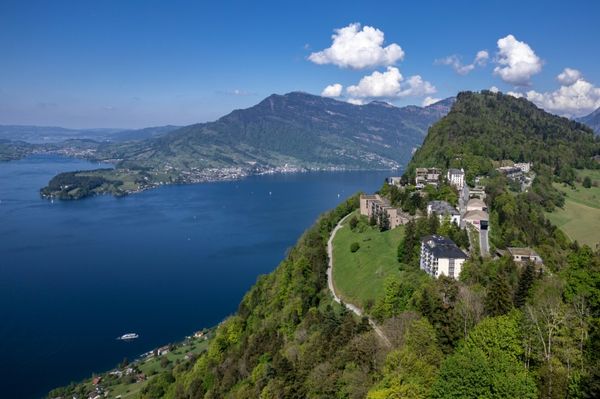
Hieronymus Bosch was a respectable citizen of a small Dutch city, a leading member of its Christian community, but in the central scene of his masterpiece, The Garden of Earthly Delights, he imagines a crazed ecstatic party without taboos or guilt. Hundreds of naked people, “black and white” as a contemporary observer noted, make love and feast on giant fruits in this rock festival of a painting. One man carries a giant mussel shell, two pairs of entangled legs poking out. Bosch’s riotous masterpiece later belonged to Philip II of Spain and was given its name by moralising authorities who saw it as a warning against false pleasures. But this is a utopia. It is not Europe. The people have no technology, no metal tools, no houses, no windmills. Those everyday details of Netherlands life appear somewhere else – in the side panel that pictures hell.

So where is this? It’s a new world, perhaps even the New World. In the wake of Columbus crossing the Atlantic in 1492, tales of the so-called “naked peoples” of the Americas were popular. Bosch at the dawn of the 1500s is inspired by them to imagine what it would be like to live a totally natural life without Christian law. And God obviously loves these innocents: he gives them huge strawberries so they don’t need to toil or spin.
Bosch’s delirious masterpiece gives my new history of the Renaissance its title and cover image. Earthly Delights puts his vision of a sexed-up, naked love-in at the centre of Renaissance art. This may seem an odd choice. Is Bosch even “Renaissance”? He lived a long way from Italy and his art betrays not the slightest knowledge of classical mythology. But that’s the point. The Renaissance wasn’t confined to one place or style. It was a convulsion of the European mind at a moment of encounter with other cultures and peoples. As Europe “discovered” far-flung places 500 years ago, it questioned its own beliefs and habits. What if the ancient doctrines of the church were not, after all, the last word about everything?
It wasn’t just a few classical scholars in Italy who were wondering this. Bosch had no contact with these “humanists” but he did live fairly near the great port of Antwerp. This is where he is most likely to have seen the Africans who appear in his art. In fact, I think he also could have seen ivory sculptures from west Africa in this port, where Portuguese merchants traded in global commodities. The bulbous spindly shapes of Bosch’s buildings resemble the salt cellars made by Sapi artists, in what is now Sierra Leone, for the European market.

Bosch also gives expression to longings much closer to home. All the dreams of medieval peasants – crushed by toil, told by the church to accept their misery in exchange for a reward in heaven – are preserved in his great painted carnival of gratification. The rites of carnival are in fact central to unlocking its mystery. Pieter Bruegel the Elder, a disciple of Bosch, created a unique visual record of these annual rites in his painting The Battle Between Carnival and Lent.) He clearly shows that carnival was an escape from Christianity, the one moment of the medieval year when people could literally stop being Christians. For on the Lenten side of his painting, monks, nuns and pious folk defend their fortress, a towering stone church. Meanwhile, the crazy carnival crowd gather outside an inn, drinking, leching, scoffing.
The Renaissance itself, like this painting, can be seen as one vast carnival. But like all parties it came to an end.
Biagio da Cesena has stood naked in the Sistine Chapel being fellated by a snake – it’s actually biting his penis, but the ambiguity is intentional – for almost five centuries now. When Michelangelo was working on his fresco The Last Judgment above the altar, this clerical official complained that, with all its nudes flaunting themselves, it was more suited to a bathhouse or tavern than the holiest place in Christendom. So after Biagio left, Michelangelo painted him as Minos, judge of hell, serpentine fellatio and all.

What a shame the great painter, sculptor, architect and poet wasn’t around to make a similar stiletto of a response when the principal of a Christian school in Florida had to resign earlier this year for showing pupils an image of Michelangelo’s statue David. One of the shocked parents called Michelangelo’s marble nude, first unveiled in 1504, “pornographic”.
As he painted his personal vision of the end of the world on the Sistine Chapel altar wall, returning in his 60s to the same place whose ceiling he’d frescoed as a young man, Michelangelo sailed into a storm not so different from today’s culture wars. Then as now he was accused of pornography. Biagio was the first critic of The Last Judgment, but many more jumped in to denounce it, from monks to the astonishingly hypocritical writer Pietro Aretino who had written verses to accompany explicit illustrations of sexual positions.
What was going on? Why were so many people piling on to make themselves sound holy by calling for the censoring of Michelangelo’s masterpiece? The Renaissance was coming to an end, and they were climbing into the lifeboats as the church turned against this era of licence. It’s at this moment, when it started to be condemned, that we can see how subversive the Renaissance had really been.
For, like a carnival, it turned the norms of Christianity upside down. It vindicated not just heterosexual passion but queer desire too. Michelangelo thought he could fill the Sistine Chapel with nudes and even paint men kissing each other in the heights of the Last Judgment because he’d been getting away with this all his life. When he was about 17, encouraged by the gay Florentine poet Angelo Poliziano, he painted a seething scene of mostly naked men struggling and writhing, The Battle of the Centaurs. It looks like a sweaty disco rendered in marble. He later sent love poems to a young nobleman called Tommaso de’ Cavalieri in which he openly declares his love while using the philosophy of Plato to defend his “honest desire”. This happened in a Europe where the church condemned sodomy as a mortal sin and states prosecuted it as a capital crime.
Those terrifying strictures could be sidestepped in a Renaissance culture consciously attempting to imitate ancient Greece, where same-sex desire had been licit and celebrated. Leonardo da Vinci was accused of sodomy but got away with it. Albrecht Dürer was, in modern terms, bisexual.

Both Leonardo and Michelangelo used religious paintings to name their love. Michelangelo does it in The Last Judgment where his kissing male figures are as brave as his poetry. Leonardo had already put his own case in The Last Supper in Milan. The androgynous pink-shawled Saint John, at Christ’s right hand, is not, as Dan Brown thought, a woman. This is simply the way Leonardo depicted his own male ideal. His biographer Vasari claimed he loved those long-haired looks in his male assistant Salaì. Leonardo, I argue in my book, puts an outrageous twist on the Bible itself. For does it not say in the Gospel of Saint John that at The Last Supper: “There was leaning on Jesus’ bosom one of Jesus’ disciples, whom Jesus loved”?
In his portrayal of John, Leonardo asserts the holiness of his own desires. The laxity couldn’t go on, declared the Council of Trent, which set out to purify the Catholic faith. No more nudes in churches – male or female. After Michelangelo died, draperies were painted on the figures in The Last Judgment. Most are still there. So the attack on Renaissance nudity by the US religious right is in line with Vatican policy.
The Renaissance was one of those eras in history when freedom won victories over fear. We need to fight for our freedoms, just as Renaissance artists did. Rich or poor, we all have a right to our earthly delights.
• Earthly Delights: A History of the Renaissance by Jonathan Jones is published by Thames and Hudson on 19 October (£30). To support the Guardian, buy your copy at guardianbookshop.com. Delivery charges may apply.







